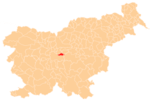Kamnica, Dol pri Ljubljani
Kamnica (pronounced [ˈkaːmnitsa]) is a settlement northeast of Ljubljana in the Municipality of Dol pri Ljubljani in the Upper Carniola region of Slovenia.[2] It includes the hamlet of Sveta Helena (German: Sankt Helena[3]).[4]
Kamnica | |
|---|---|
 Kamnica Location in Slovenia | |
| Coordinates: 46°5′51.41″N 14°40′29.92″E | |
| Country | |
| Traditional region | Upper Carniola |
| Statistical region | Central Slovenia |
| Municipality | Dol pri Ljubljani |
| Area | |
| • Total | 1.09 km2 (0.42 sq mi) |
| Elevation | 268.3 m (880.2 ft) |
| Population (2002) | |
| • Total | 294 |
| [1] | |
History
In the past, Kamnica was known for black slate, which was mined here and used for slate roofing. It was also known for millstones.[4]
Žerjav Castle
Žerjav Castle is a 16th-century manor. It was built in 1580 by Lenart Frumentin, a priest in the Teutonic Knights. There is a stone plaque with a crest above the manor entrance. Next to the stall belonging to the castle is a well with an inscription stating that it was installed in 1591.[4] Ownership of the manor was later assumed by the Austrian Empire, which in turn deeded it to the Račič family for its services during its war against the Republic of Venice. The castle was nationalized after the Second World War. A tree-lined avenue formerly stood along the route from Dolsko to the manor, with heritage cultivars of pears on the right and apples on the left. It was cut down in the 1950s. The avenue was replanted with linden trees in 2012.[5]
- Crest and inscription on the castle
- Replanted tree-lined avenue to the castle
Church
The local church stands next to Žerjav Castle and is dedicated to Saint Helena.[6] The church was first mentioned in written sources in 1495, and the first church at the site was built by the owners of Žerjav Castle. Tradition states that it was dedicated to Saint Helena by the lady of the castle, who was named Helena.[5] The original church was razed in the late 18th century, and the new structure was built between 1794 and 1797. The main altar features a painting of Saint Helena by Ivan Grohar. The side altars have paintings by Marko Layer (1727–1808) and Henrika Langus (1836–1876), and there is a painting of the Holy Sepulcher by Matija Koželj. An old painting of the Virgin Mary by an unknown artist hangs in the sacristy. Kamnica was elevated to a parish in 1875.[4]
Notable people
Notable people that were born or lived in Kamnica include:
- Josip Armič (1870–1937), education specialist and writer of beekeeping and hunting articles[4]
References
- Statistical Office of the Republic of Slovenia
- Dol pri Ljubljani municipal site
- Leksikon občin kraljestev in dežel zastopanih v državnem zboru, vol. 6: Kranjsko. 1906. Vienna: C. Kr. Dvorna in Državna Tiskarna, p. 18.
- Savnik, Roman, ed. 1971. Krajevni leksikon Slovenije, vol. 2. Ljubljana: Državna založba Slovenije. p. 362.
- Žerjavov grad, cerkev sv. Helene, dr. Janez Janež, Drevored. Signboard in Kamnica.
- Visit Ljubljana site
External links

- Kamnica on Geopedia
